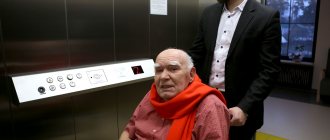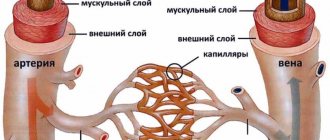Niemann-Pick disease is an inherited disease that causes fat to accumulate in various organs, most commonly the liver, spleen, brain and lymph nodes. This disease has several clinical forms, each of which has its own prognosis. There is no specific treatment, high risk of death. Niemann-Pick disease affects both males and females equally.
Do not self-medicate. At the first signs of illness, consult a doctor.
- Etiology
- Classification
- Symptoms
- Diagnostics
- Treatment
- Forecast
Treatment and rehabilitation
Typically, the involvement of a nutritionist, physiotherapist, occupational pathologist (correction of motor skills, walking balance), neurologist (treatment of epileptic seizures and assessment of neurological condition), speech therapist, pulmonologist, geneticist, gastroenterologist, psychologist, social worker and nurse is required.
There is currently no effective treatment for sphingomyelinosis type A. There are some positive results in treating patients with type B with bone marrow transplantation. Research continues into possible treatments, including gene therapy and enzyme replacement therapy. There are currently no medications available to treat Niemann-Pick disease type D. A drug called miglustat is used to treat nervous system disorders in type C.
Patients with all types of this disease are advised to eat a healthy diet with low cholesterol levels. However, research does not confirm that such measures will help combat complications or change how cells metabolize cholesterol. However, a number of medications improve the course of the disease, for example, epileptic seizures and sudden loss of muscle tone.
All types of Niemann-Pick disease require constant care and medical supervision. Life expectancy and its quality directly depend on the type of disease and the quality of medical care provided.
Sphingomyelinosis type A is an extremely serious disease, usually leading to death before the age of 2-3 years. Patients with type B may survive into adolescence or adulthood. Type C, when the first symptoms appear before one year of age, can lead to death before reaching school age. Those patients who develop symptoms after school age may survive until the end of adolescence, and some live into their 20s or more.
Possible complications:
- blindness;
- brain damage accompanied by mental retardation and delayed development of motor skills;
- deafness.
Classification
There are 3 types of development of Niemann-Pick disease:
- Type A disease is the classic form of Niemann-Pick disease and has an infantile appearance. Symptoms begin to appear in children in the first year after birth - these are spasms of the body and its individual organs, deviations in the swallowing reflex, and the absence of many reactions. With this type of pathology, death occurs in children under 3 years of age;
- Type B disease is a visceral type of Niemann-Pick syndrome. This pathology can occur between the ages of 2 and 6 years. In type B disease, the liver and spleen cells are predominantly affected. With type B, death occurs less frequently, but the risk of its occurrence is still high. With this type of pathology, many patients survive to adulthood;
- Type C disease is an adolescent form of pathology. The first symptoms appear before the age of 5, but they become more intense from 15 to 18 years of age. In type C Niemann-Pick syndrome, internal organs and brain cells are damaged. The mortality rate is high. Many teenagers die between the ages of 15 and their 18th birthday.
The visceral form of Niemann-Pick disease is the most favorable form of development of the pathology, with the lowest mortality rate. It is diagnosed quite rarely and its manifestations are not pronounced.
Pick's disease - symptoms of the disease
Clinical manifestations depend on the type of disease. Different types have their own characteristics and severity of the disease. Life expectancy also differs with different forms of gene dysfunction.
Type A
Niemann-Pick disease type A is an inherited disease that most often occurs in Jews from Central and Eastern Europe. In this variant of the disease, the lipid sphingomyelin is not broken down at all and quickly fills the cells, causing disruption of their functions. The cells increase in size and quickly die, being replaced by scar tissue.
With Pick's disease, symptoms appear in infancy - at 3-5 months. These babies have difficulty feeding, do not gain weight, and are stunted. The belly of such children is proportionally larger than the body due to the enlargement of the liver and spleen. The main symptoms of Pick's disease type A:
- early onset of the disease (3-5 months),
- vomiting, frequent diarrhea,
- temperature increase,
- weight loss, muscle atrophy, lethargy,
- The volume of the abdomen constantly increases,
- delayed psychomotor development (the child does not touch his fingers, does not sit down),
- convulsions,
- vision is impaired, children do not fix their gaze,
- hearing decreases, children react poorly to sounds.
Type A is characterized by rapid progression of disease symptoms. The affected cells die, and the death of brain cells causes problems with swallowing, breathing and circulation. Such children rarely live beyond 3-5 years.
Type B
A feature of the course of Pick's disease type B is the lack of lipid accumulation in nerve cells. Thus, nerve cells are not destroyed and symptoms of brain dysfunction do not appear. In these children, intellectual abilities do not suffer; in some cases, patients demonstrate quite high mental talent.
The first symptoms of the disease appear after 3 years. First of all, the spleen and later the liver begin to enlarge in children. With age, symptoms of lung damage appear. The lipid accumulates in the lymph nodes and causes a decrease in the activity of the immune system; children often get sick. The life expectancy of such patients is somewhat reduced, but they live to adulthood, sometimes even to old age.
Manifestations of Niemann-Pick disease type B:
- increase in abdominal volume (due to enlargement of the liver and spleen),
- periodic dull pain in the abdomen,
- nausea, sometimes vomiting,
- dysfunction of the liver and gallbladder (yellowness of the skin and eyes),
- increased bleeding (the liver does not produce components for blood clotting in sufficient quantities).
- shortness of breath during moderate physical exertion,
- frequent respiratory infections and colds.
Type C
Type C Niemann-Pick disease appears after the first years of life. At the onset of the disease, damage to internal organs occurs - enlargement of the liver and spleen, lymph nodes.
With this variant of the sphingomyelin lipid metabolism disorder, both internal organs and the nervous system are affected.
Symptoms of damage to internal organs:
- increase in abdominal volume,
- aching, dull pain in the abdomen,
- yellowness of the skin, mucous membranes and eyes,
- enlarged and painful lymph nodes,
- dyspnea,
- frequent bronchitis and pneumonia.
As the disease progresses, symptoms of damage to the nervous system appear. Manifestations of disorders of the brain and spinal cord are constantly increasing, patients lag behind their peers in mental and physical development. As the disease progresses, children lose skills and abilities that they have already mastered. For example, a child has already learned to speak, but over time, speech becomes disrupted and becomes less intelligible.
Damage to cells of the nervous system constantly progresses and causes disorders incompatible with life. Typically, such patients live 15-20 years.
- tremor of fingers, loss of coordination of movements,
- convulsions, epileptic seizures,
- swallowing and breathing disorders,
- loss of speech and other acquired skills,
- memory and thinking disorders, decreased school performance,
- behavioral disorders, withdrawal,
- emotional instability, irritability, depression.
Niemann–Pick disease type C: diagnosis, follow-up and treatment of patients in Russia
Niemann–Pick disease belongs to the group of lysosomal storage diseases and is characterized by autosomal recessive inheritance. For pediatric neurologists, Niemann-Pick disease type C is of particular interest due to the polymorphism of clinical symptoms unusual for childhood, which depends on the age of manifestation of the disease (muscle hypotonia, delayed psychomotor development, cataplexy, dysphagia, intellectual disability, ataxia, etc.). The only method of pathogenetic treatment of Niemann-Pick disease type C is substrate-reducing therapy with miglustat (Zaveska®). The effectiveness of the drug in improving neurological symptoms (spontaneous eye movement in the vertical plane, impaired swallowing function, impaired coordination of movements, etc.), stabilizing the disease or slowing its progression has been proven. Miglustat has a favorable safety profile. Early diagnosis of this orphan disease is fundamental to the effectiveness of therapeutic interventions.
Table 1. Prevalence of rare (orphan) lysosomal storage diseases [3]
Table 2. Molecular genetics of Niemann–Pick disease, type C
Table 3. Frequency of clinical manifestations of Niemann–Pick disease, type C [7]
Table 4. Recommended dose of Zavesca® for Niemann-Pick disease, type C, depending on body surface area
Table 5. Safety profile of Zavesca® [21]
Table 6. Symptomatic treatment of patients with Niemann–Pick disease, type C [11]
In recent years, attention to rare (orphan) diseases, and in particular to lysosomal diseases, has increased significantly. First of all, this is due to the revelation of the essence of many lysosomal diseases. An equally important stimulus to the study of lysosomal diseases was the discovery of the possibility of their pathogenetic treatment using enzyme replacement agents. An extensive group of lysosomal storage diseases, including 45 nosological forms, includes Niemann–Pick disease type C [1].
Definition, frequency and etiology of Niemann–Pick disease type C
Lysosomal storage diseases are characterized, as a rule, by early manifestation of the disease, progression of the course, severe damage to vital organs and systems of the body, leading to early disability and premature death, often starting from the neonatal period. Niemann-Pick disease type C is clearly distinguished from other forms of lysosomal diseases, including Niemann-Pick disease type A and type B, is an independent disease and belongs to the category of rare (orphan) diseases.
The incidence (incidence) of Niemann–Pick disease type C is 1:100,000–1:120,000 live births [2]. The estimated prevalence of Niemann–Pick disease type C is 0.85 per 100,000 population [3]. In reality, the prevalence is obviously higher, which may be due to the presence of unregistered cases, incorrect diagnosis, incomplete diagnosis, etc. The disease is pan-ethnic in nature and widespread everywhere. A high incidence of Niemann-Pick disease type C1 has been noted among some genetic isolates: the French colony of Acadia (Nova Scotia), Bedouin groups in Israel, Spanish settlements in Colorado and New Mexico, which is associated with the founder effect.
Among other lysosomal storage diseases, Niemann–Pick disease type C occupies a middle position in terms of prevalence. Comparative data on the prevalence of individual forms of lysosomal diseases are presented in table. 13].
In the Russian Federation, diagnosis of Niemann–Pick disease type C began in 2008. At the beginning of 2013, 11 patients were diagnosed, of which 2 were foreign citizens. Among the diagnosed patients there are 10 children from 3 to 18 years old and 1 adult (26 years old). Treatment has begun for 7 people. The predicted number of patients is more than 170 people.
Niemann-Pick disease type C is a progressive autosomal recessive hereditary neurodegenerative disease with hepatosplenomegaly associated with dysregulation of intracellular lipid trafficking [4]. It is characterized by an unfavorable prognosis in the absence of timely and adequate specific treatment (substrate-reducing therapy). The etiology of the disease is associated with mutations in the NPC1 gene (in 95% of cases) or in the NPC2 gene (about 5% of cases) - Niemann-Pick disease, types C1 and C2, respectively [5], which leads to disruption of intracellular lipid transport and accumulation of cholesterol and glycosphingolipids in the brain and other tissues (Table 2).
Both types of the disease are inherited in an autosomal recessive manner. The NPC1 gene is mapped on the long arm of chromosome 18, in the q11-q12 locus – 18q11-q12. The Niemann–Pick disease gene NPC2 is localized on chromosome 14, in the region of its long arm – q24.3 – 14q24.3 [5].
Pathogenesis
Niemann-Pick disease type C develops as a result of hereditary failure of intracellular (lysosomal) transport of lipids (cholesterol) and their esterification (impaired fat metabolism), which leads to the accumulation of free non-esterified cholesterol in the cells of various tissues, secondary accumulation of sphingomyelin and glycosphingolipids (sphingomyelin lipidosis) mainly in the brain with profound functional and structural changes in neurons, as well as Gm2- and Gm3-gangliosides [6]. In this disease, other organs (particularly the liver and spleen) are almost always involved.
Niemann–Pick disease type C is characterized by normal levels of the lysosomal enzyme sphingomyelinase.
Clinical picture and diagnosis
Most often (in 70% of all cases) the disease manifests itself between the ages of three and eight years. Less commonly, the onset of pathology can be observed between 10 and 15 years of life. Along with this, isolated cases of the onset of the disease in the neonatal period with jaundice and splenomegaly and in adults (55 years or more) have been described. As a rule, until the manifestation of the main clinical symptoms of the disease, the psychomotor development of patients remains normal.
Early typical signs of Niemann-Pick disease type C in preschool children are impaired coordination of movements, ataxia, tremor, dysarthria, and choreoathetosis. The onset of the disease at school age and in adults is usually manifested by disorders of cognitive activity with the subsequent formation of mental retardation. A decrease in intelligence is characteristic of all cases of the disease, but the degree of its severity may vary. The pathognomonic symptom of the disease is gaze paralysis when looking up and down. Quite often (about one third of patients) convulsive paroxysms develop, which are focal or generalized. Seizures are usually resistant to anticonvulsant therapy. A characteristic feature of types C1 and C2 is hepatosplenomegaly, which can manifest itself both at the onset of the disease and after the development of neurological symptoms. The frequency of clinical manifestations of the disease is shown in table. 3 [7].
The disease progresses steadily, ending in death, usually between 5 and 15 years of life. Variants with a later onset of the disease (during school years and in adults) are characterized by a significantly slower progressive course [8, 9, 10].
Types C1 and C2 are similar in their clinical manifestations.
The following clinical forms of the disease are distinguished [11, 12].
Neonatal form
manifests up to three months of age; often debuts with intrauterine fetal hydrops. In the newborn period, the main symptoms may be prolonged jaundice, hepatosplenomegaly, ascites, and muscle hypotension.
Early infantile form
manifests itself between the ages of 3 months and 2 years; characterized by hepatosplenomegaly, delayed psychomotor development, muscle hypotonia, and progressive cerebellar disorders (ataxia).
Late infantile form
manifests at 2–6 years of age. The main clinical manifestations are progressive ataxia, dysarthria, behavioral disorder, hepatosplenomegaly, intellectual disability, vertical gaze paresis, epilepsy, spasticity, cataplexy, dysphagia, dystonia. Fatal outcome – at the age of 7–12 years.
Youth (juvenile) form
manifests from 6 to 15 years; characterized by delayed psycho-speech development, behavioral disturbances, cerebellar (ataxia, intention tremor, dysarthria, changes in gait) and extrapyramidal (muscle hypotonia, various types of hyperkinesis) disorders, various types of epileptic seizures, and sometimes polyneuropathy. A specific symptom is vertical ophthalmoparesis.
Adult form
– onset of the disease over the age of 15 years, manifested by ataxia, dystonia, psychiatric symptoms, hepatosplenomegaly, dementia.
The disease is characterized by a wide range of clinical manifestations. The average age at diagnosis is 10.4 years, life expectancy is 16.2 years, and life expectancy is 38 years.
Therapeutic prospects increase the importance of timely diagnosis of Niemann-Pick disease type C, which should be based on the clinical alertness of neurologists, pediatricians, psychiatrists, therapists, geneticists and other specialists who may include patients with the disease in question [13].
For diagnosis, biochemical methods are used (accumulation of non-esterified cholesterol in lysosomes, Philipin staining to detect lipid accumulation), histological methods (foam cells in bone marrow and spleen biopsies, azure histiocytes in bone marrow biopsies, polymorphic bodies in the cytoplasm of skin, liver or brain cells ). Genetic methods (DNA diagnostics) are used to confirm the diagnosis, prenatal diagnosis, and identify homozygotes in proband families. To identify atrophic changes in brain structures, magnetic resonance imaging (MRI), computed tomography, and proton magnetic resonance spectroscopy are used.
Data from laboratory, functional and pathomorphological studies are also used. MRI of the brain diagnoses symmetrical atrophy of the cortex, cerebellum and hypoplasia of the corpus callosum. In biopsy samples of the liver, spleen, lymph nodes, bone marrow, tonsils, kidneys, lungs and smooth muscles, “foamy” cells with lipid PAS-positive inclusions are detected. Light microscopy reveals the deepest damage to the neurons of the globus pallidus, caudate nucleus and cranial nerves with the accumulation of PAS-positive lipids in them. Glia cells also record deposits of fats, cholesterol and lipids. Electron microscopy reveals concentric lamellar bodies in neurons, similar in structure to inclusions in Gm2 gangliosidoses.
Differential diagnosis, treatment and prevention
Niemann-Pick disease type C should be differentiated from other storage diseases: Gm1- and Gm2-gangliosidoses, mucopolysaccharidoses and Gaucher disease.
Obviously, for Niemann-Pick disease type C, etiotropic treatment (gene therapy) would have the greatest effect, but it has not yet been developed.
Pathogenetic therapy
Due to little knowledge of the pathogenesis of the disease, pathogenetic methods of therapy for Niemann–Pick disease type C began to be developed relatively recently. Knowledge of the mechanisms of damage to the nervous system, in particular the assessment of the number of viable neurons in the central nervous system (CNS), is extremely important for the success of therapeutic interventions. This is the basis of targeted therapy used in the treatment of hereditary neurodegenerative diseases, one of the representatives of which is Niemann-Pick disease type C.
Clinical studies have examined the effectiveness of using cholesterol-lowering agents (lowering intracellular cholesterol levels) or restricting cholesterol intake. Despite the fact that such therapy caused a decrease in cholesterol levels in the liver and plasma, no improvement in neurological manifestations was noted [14, 15]. Attempts were made to transplant bone marrow or liver, which partially normalized the accumulation of cholesterol and sphingomyelin in tissues. However, these methods were ineffective in treating neurological symptoms in patients with mutations in the NPC1 gene [16].
Because Niemann–Pick disease type C is usually diagnosed late, patients have already damaged or lost a significant portion of their central nervous system neurons. In this case, the goal of therapy is to preserve viable neurons, stabilize the disease and reduce the rate of progression of the pathological process. The severity of damage to the nervous system varies among patients, so the choice of therapy should be individualized [17].
Difficulties in treating Niemann–Pick disease type C still persist. This is primarily due to the lack of knowledge of the pathogenetic mechanisms of the disease, late diagnosis and the paucity of scientific research in this direction. The situation began to change after the creation of a new generation drug - miglustat (Zaveska®) and the development of a new direction in the treatment of lysosomal diseases - substrate-reducing therapy.
Establishment of the molecular genetic nature of Niemann-Pick disease type C, the nature of biochemical disorders, identification of mutant genes and their chromosomal localization made it possible to develop new approaches to the treatment of this lysosomal disease associated with the use of agents that prevent the formation of initial products (substances) that are precursors accumulated substrates. In Niemann–Pick disease type C, it was possible to reduce the formation of glycosphingolipids as initial accumulation products by suppressing the enzyme glycosylceramide synthase (the first enzyme in the synthesis of most glycolipids) using a specific drug, miglustat. Accordingly, a decrease in the synthesis of the initial biochemical metabolic products (glycosphingolipids) leads to a decrease in their accumulation in the organs and tissues of the body. Substrate-reducing therapy can be called a new direction of pathogenetic treatment, since it is aimed at interrupting the initial pathogenetic link of the disease.
Miglustat (international nonproprietary name (INN) - miglustat; trade name - Zaveska) was developed and introduced for the treatment of patients with Niemann-Pick disease type C by Actelion (Switzerland). According to the chemical structure, miglustat is N-butyldeoxynojirimycin (NB-DNJ) and belongs to iminosugars. The most important property of miglustat, which is an inhibitor of glycososphingolipid synthesis, is its ability to penetrate the blood-brain barrier [18]. Miglustat, along with inhibiting glycosylceramide synthase, the initial enzyme in the formation of glycosphingolipids, also inhibits sucrose-isomaltase and other disaccharidases in the small intestine, which underlies the gastrointestinal side effects of miglustat. Under the influence of miglustat, the accumulation of toxic metabolites (gangliosides GM2 and GM3, lactosylceramide and glycosylceramide) and their neurotoxic effect are prevented. However, miglustat does not inhibit the synthesis of sphingomyelin and galactosylceramide (the main component of myelin), nor does it cause ceramide accumulation [11].
Zavesca® (miglustat) was approved by the US Food and Drug Administration (FDA) as the first drug treatment for Niemann-Pick disease type C and was subsequently approved in Europe (January 2009). .). For use in the Russian Federation, Zaveska® was registered in November 2009 (registration number: LSR-008892/09). The drug is available in capsule form (1 capsule contains 100 mg) for oral administration.
In the United States, miglustat was given orphan drug status in 2008.
To date, Zavesca® is the first and only drug registered for the treatment of Niemann-Pick disease type C. Given the mechanisms of action of miglustat, it is also used in Gaucher disease as a substrate-reducing therapy.
In connection with the advent of a drug for the pathogenetic treatment of Niemann-Pick disease type C, two acute problems have arisen: 1) the need for early diagnosis of the disease, 2) the prescription of treatment as early as possible. So far, unfortunately, the developed drug is recommended for use in children with Niemann-Pick disease type C starting from the age of four. It is clear that a positive decision on the use of miglustat in young children is not only a matter of time, but also of early diagnosis of the disease, as well as the recruitment of the necessary cohort of patients and the conduct of appropriate clinical trials.
Indications for use of the drug Zaveska® are:
- treatment of progressive neurological symptoms in adults and children with Niemann–Pick disease type C, which may slow progression of the disease;
- oral therapy for mild to moderate Gaucher disease type I, including those who are intolerant or unable to use enzyme replacement therapy in adults [19].
For Niemann-Pick disease type C, the recommended dose of Zaveska® for adults and children over 12 years of age is 200 mg 3 times a day; for children from 4 to 11 years of age, the dose is prescribed based on body surface area (see instructions for the drug, Table 4 ).
The effectiveness and safety of miglustat (Zavesca®) have been demonstrated in a number of studies. An evaluation of the results of a multicenter study involving 66 patients with Niemann–Pick disease type C showed that the majority of patients experienced stabilization or improvement of their condition after treatment with miglustat [19]. At the same time, the rate of decrease in the total index on the modified disability scale decreased significantly, and in 75% of patients the effect of the therapy was rated as “good.” It is important to emphasize that in patients with Niemann–Pick disease type C, miglustat therapy has a positive effect on neurological disorders. In addition, when using the drug Zaveska®, there is a slowdown in the progression of the disease. In a study by MC Patterson et al. During therapy with Zavesca®, in the majority of patients of all age groups, the condition either improved or stabilized in at least 3 of 4 parameters (ataxia, dystonia, dysarthria, dysphagia) [20].
The drug is characterized by a favorable safety profile and good tolerability in both children and adults (Table 5) [21]. As shown in the study by M. Pineda et al., in which the average time of use of Zavesca® in 67 patients was 533 days, 45% of patients experienced at least one adverse reaction [21].
There are data on the effectiveness of treatment with miglustat in patients aged from 7 months to 44 years (mean age 14.68 ± 10.84 years) with Niemann-Pick disease types C1 and C2 [14]. During therapy with Zaveska®, patients with mutations in the NPC1 gene showed an improvement in swallowing function (water, puree, paste, biscuit) (according to video monitoring using videofluoroscopy (videofluoroscopic swallowing study, VFSS) - in 85% of patients; stabilization - in 81 %; improvement in the parameter “dystonia” – in 80%, “dysmetria” – in 74%, “dysarthria” – in 63%; increase in DQ from 45 to 65 units (after 24 months of treatment with miglustat). After 36 months of treatment with miglustat improvement or stabilization of symptoms was observed in 22 patients with mutations in the NPC2 gene. Thus, improvement in the parameter “spontaneous eye movements in the vertical plane" was noted in 7 patients during Zaveska therapy and in 1 patient who did not receive miglustat; no change was recorded in 8 and in 1 patient; deterioration in 2 and 3, respectively. Improvement in the oculomotor sphere was also noted in the study by M. Pineda et al.: after 12 months of using the drug Zaveska®, an improvement or stabilization of the symptom “spontaneous vertical eye movements” was shown in patients 12 years and older [21].
According to D. Bruschini et al., the use of miglustat for 2 years in 4 patients aged 11 months, 9, 10 and 12 years (3 with a mutation in the NPC1 gene and 1 with a mutation in the NPC2 gene) contributed to the normalization of swallowing function in all patients [18].
Symptomatic therapy
Along with pathogenetic treatment, symptomatic therapy is also of great importance for Niemann-Pick disease type C. Its main directions are shown in table. 6. [11].
Symptomatic drugs, although they have wide variability in their action, can be very useful in improving the condition of patients and improving their quality of life.
Particular attention should be paid to the nutrition of patients and systematically assess the ability to swallow food (there are special scales for assessing swallowing - swallowing liquid food, semi-liquid, thick, etc.). During treatment, a diet low in cholesterol and the use of drugs that reduce its level in the blood serum are recommended. If the swallowing function is significantly impaired, patients are recommended to have tube feeding or a gastrostomy tube, which makes it possible to provide patients with the necessary amount of nutrients, sufficient fluid and calories.
To correct the function of salivation in patients, atropine drops in small doses can be used.
Dysphagia is often complicated by secondary lung damage. In these situations, antibiotics may be prescribed to prevent pneumonia.
If gastrointestinal disorders develop, most often diarrhea, antidiarrheal drugs and a special diet are recommended. However, diarrhea may be a consequence of miglustat use. In these cases, to eliminate side effects during miglustat therapy and the development of diarrhea syndrome, it is recommended to review the diet and reduce the intake of lactose-containing products or intake of other carbohydrates. Separating miglustat intake from food may have a positive effect. In some cases, it is possible to prescribe antidiarrheal drugs such as loperamide or discontinue the drug Zaveska® for a short time.
To resolve emerging issues, consultations with relevant specialists (gastroenterologist, neurologist, psychiatrist, etc.) may be required.
In general, increasing the effectiveness of treatment for patients with Niemann–Pick disease type C is possible by following a number of fundamental principles:
- accurate diagnostics (institutions, methods, regional and federal registers, etc.);
- qualified medical opinions (consultant, regional council, federal council, etc.);
- developed and approved treatment standards (financial and economic calculations, financing, etc.);
- developed and approved clinical guidelines (international, federal, etc.);
- effective interaction in the provision of medical care (children - adults, institutions, doctors, approved documentation);
- advisory assistance during the treatment process (institutions, experts);
- timely replenishment of the list of vital and essential drugs (inclusion of drugs, orphan drugs, etc.).
The prognosis of the disease is significantly improved with the use of miglustat (Zaveska®).
Prevention
Prevention is based on data from medical genetic counseling. The medical genetic risk for the proband's siblings is 25%. If the genotype of the proband and the types of mutations in carriers are established, prenatal diagnosis of Niemann-Pick disease types C1 and C2 is possible. The diagnosis can be established at 10–12 weeks of pregnancy with a molecular genetic study of chorionic villus biopsy. In some cases, the study of sphingomyelinase activity in amniocytes and chorionic villus biopsies using biochemical methods can provide some assistance, but such an analysis requires a cell culture.
Transmission routes
Genetics is developing at an increasingly rapid pace, and there is every reason to assert that a gene, as a fragment of DNA, is indeed a carrier of hereditary characteristics, but transmitted not in exact form, but in the state of mosaic particles.
This means that under the influence of various factors that form memory loss and decreased mental abilities, only a small part of the genetic material that carries a tendency to develop dementia can be passed on to the descendant.
If a descendant is concerned with the health of the body and mind, then diseased genes may well undergo changes and lose the lion's share of their impact, that is, correction of inherited genes is possible.
Gene differences are divided into two main types:
- Variation (not carrying pathologies).
- Mutated (changed, capable of harm).
Dementia can develop under the influence of both types of genes, and it is enough that just one gene was mutated for a person to be doomed to a certain disease, and this is not always dementia.
When should you see a doctor?
The first visit to the doctor should be at the moment when the couple is planning to have a child, if there are relatives in the family with Niemann-Pick genetic pathology.
It is also necessary to consult a geneticist if the child has signs of sphingomyelinosis pathology:
- The child is developmentally delayed;
- The child has insufficient appetite, or its complete absence;
- The baby is not gaining enough body weight.
Heredity and genetics
Alzheimer's syndrome is one of the types of senile dementia, and the most common.
Statistics show that more than 50% of elderly people are susceptible to this disease to one degree or another. Is Alzheimer's disease inherited?
Geneticists have been able to establish through research that there is indeed some dependence on hereditary factors: the likelihood of developing senile dementia of the Alzheimer's type increases significantly if one of the close relatives has been affected by this disease.
In the case where dementia affects not one, but two family members, this fact should seriously alert the younger generation: the probability doubles, as evidenced by statistical data.
From the editor: Tips and exercises for developing attention
These data allow scientists to claim that this disease is hereditary in nature, that is, it is genetically determined.
The disease affects brain cells, the volume of which decreases, which is visible to the naked eye according to the results of CT and MRI studies.
Alzheimer's syndrome is not infectious, which excludes the possibility of infection. It is impossible to become infected with this disease: it is not the disease that is transmitted, but a predisposition to it.
The mechanism of the occurrence of dementia is not fully understood; there are many theories about what exactly serves as an impetus for the body.
The discovery of symptoms similar to the manifestations of this particular disease does not give reason to make such a diagnosis for yourself, even if several ancestors suffered from dementia.
You can find a test on the Internet and answer questions - it’s interesting and educational, but it does not answer the question of whether Alzheimer’s disease has begun to progress.
Only specialists, after conducting a series of tests and studies, will be able to make an accurate diagnosis, because the manifestations of this disease only indicate memory problems, and similar symptoms are observed in other diseases.
For example, atherosclerosis also leads to the development of senile dementia, but it is still a completely different disease that requires different preventive and medicinal measures.
Heredity, age, gender as causes of Alzheimer's disease:
How to help a patient and what are his chances
To date, there is no general method for treating Pick's disease. All a doctor can do is prescribe medication to delay progressive changes and improve a person’s condition.
However, modern medicine has discovered five areas of treatment that can achieve the greatest effect in slowing the progression of dementia. These include:
- Replacement therapy
- acetylcholinesterase inhibitors, monoamine oxidase inhibitors, antidepressants. The action of these drugs is aimed at replenishing the deficiency in the human brain of certain substances that are no longer produced in the required quantities due to atrophy. - Neuroprotectors
– neurotrophic substances, calcium channel blockers, antioxidants, growth factors. These drugs help stimulate brain cells. As a result, metabolic processes are significantly improved, and this helps slow down the death of neurons and atrophy of the cerebral cortex. - Anti-inflammatory drugs
are also used . - Pharmacological correction
of existing mental disorders in humans. In this case, antidepressants and drugs that suppress aggression are prescribed. - Psychological professional assistance
. This therapy includes various trainings. This technique is very effective in slowing the progression of the disease.
Psychological help from relatives plays an important role in therapy. It is very dangerous to leave patients alone, because a person in the later stages of the disease is completely unable to account for his actions.
There are cases when patients started fires, left gas open, and committed other destructive actions. Thus, it becomes clear that they simply begin to pose a danger to others and to themselves in the first place.
When this disease is diagnosed, the prognosis for life is unfavorable. A person becomes helpless, incapable of self-care, so he needs round-the-clock supervision, he loses social and communication skills, becoming asocial.
Within five years, the disease leads to moral personal decay and a state of complete decline in psychophysical activity sets in.
Symptoms
Pick's disease has three stages in its course, which develop depending on the lesion, as follows:
- Initial stage.
- Stage of loss of cognitive functions.
- Profound dementia.
initial stage
The symptoms of the disease at the very first stage are not much different from the symptoms of Alzheimer's disease, the difference is that the course of the disease is more rapid and malignant.
Thus, at the initial stage, a person’s boundaries of what is permitted are erased, he becomes more liberated and does not realize what caused dissatisfaction with this or that action on his part, a disinhibition of instincts occurs, all this leads to the following manifestations:
- antisocial behavior;
- selfishness;
- loss of moral principles;
- increased libido;
- decreased self-criticism;
- “gramophone record” symptom (repeated repetition of phrases, jokes, stories, some “secret” information).
In addition, there is a possibility of developing bulimia, and depending on which hemisphere is affected by depression or excessive euphoria (the left hemisphere is depressive, the right is euphoric).
In addition, additionally, in the case of convexital atrophy of the frontal lobe, the patient experiences:
- apathy;
- loss of desires;
- silence.
In the case of frontal lobe atrophy:
- personal changes;
- emotional instability.
With changes in the temporal lobes, the patient becomes overly suspicious, he feels abandoned and useless, which also leads to the formation of depression.
Stage of cognitive loss
At this stage, in addition to the previously listed symptoms, disorders associated with the cognitive functions of the body are added, including:
- loss of writing, counting and reading skills;
- memory impairment;
- inability to perform actions consistently (lack of logic in actions);
- decrease in speech reserve (up to the state of “Ellochka the cannibal”);
- inability to consciously perceive what is said to him.
At the very beginning of the second stage, these symptoms and signs may appear periodically, but every day the periods of normal functioning of the body become shorter and shorter, and cognitive impairment eventually becomes chronic and occurs constantly.
In addition, in some cases there is a phenomenon such as sudden changes in weight. First, the patient sharply gains weight and is diagnosed with obesity, after which the gained weight almost doubles. This entails disruption of physiological processes in the patient’s body, general weakness and exhaustion.
Profound dementia
This stage is fatal and usually leads to the death of the patient. It is characterized by the patient’s inability to perform basic actions (use of cutlery, use of personal hygiene products, etc.).
As a rule, at this stage the patient is completely immobilized and bedridden. Death occurs as a result of the formation of concomitant infectious diseases and symptoms characteristic of bedridden patients.
Rapid progress of the disease
Pick's disease develops rapidly. These are the stages of disease development.
Initial stage of development
At the first stage, character changes occur. A person becomes egoistically oriented and performs actions that are atypical for him:
- emotional emancipation - moral principles are devalued, sexual promiscuity arises;
- changes in speech - the patient often repeats the same jokes and words;
- loss of self-control;
- disturbances in the psycho-emotional sphere - hallucinations, increased feelings of jealousy and inferiority occur.
Second stage
Symptoms progress unnoticed, may occur periodically, and then become constant:
- onset of amnesia;
- speech disorders, the patient becomes unable to express himself clearly using words, and there is no understanding of the meaning of other people’s speech.
- impairment of the ability to perform even the simplest actions;
- deformation of visual, auditory, tactile perception;
- loss of ability to perform oral and written actions, counting.
At the last stage, dementia takes on a deep, irreversible form. The patient becomes unable to self-care and requires full care.
Diagnostics
The diagnosis is verified by a combination of clinical symptoms, biochemical studies, genetic testing, and instrumental diagnostics.
- Detection of the accumulation of non-esterified cholesterol in skin fibroblasts when stained with filipin.
- Increased levels of plasma chitotriosidase.
- Increased levels of cholesterol oxidation products.
- Genetic research: identification of pathogenic mutations in the NPC1 or NPC2 genes.
- MRI of the brain: cerebral and/or cerebellar atrophy, increased white matter density.
- Ultrasound of the abdominal cavity: hepatosplenomegaly.
Hereditary neuromuscular diseases
Hereditary neuromuscular diseases are represented by the most extensive group of pathologies.
Group 1 of neuromuscular dystrophy includes spinal amyotrophies. Common forms of spinal amyotrophy include:
- progressive spinal Aran-Duchenne amyotrophy, observed in adults;
- Kugelberg-Welander juvenile amyotrophy;
- childhood form of Werdnig-Hoffmann amyotrophy.
The second group of neuromuscular dystrophy is represented by neural amyotrophies. These diseases can be either familial or sporadic. This group of diseases usually manifests itself in childhood or adolescence. This group of neuromuscular dystrophies includes:
- Roussy-Lévy syndrome;
- neural form of amyotrophy Charcot-Marie-Tooth;
- Refsum's disease;
- hypertrophic interstitial neuropathy Dejerine-Sotta.
A large group of neuromuscular diseases is represented by primary progressive muscular dystrophies. Manifestations of primary progressive muscular dystrophies can be varied. Prominent representatives of this group of diseases are:
- pseudohypertrophic childhood dystrophy Duchenne;
- favorable current pseudohypertrophic dystrophy of Becker-Keener;
- juvenile and end-lumbar Erb's dystrophy;
- distal muscular dystrophy;
- oculopharyngeal and ocular forms of dystrophy;
- rigid spine syndrome;
- non-progressive muscular dystrophy.
- hereditary paramyotonia Eulenburg;
- Thomsen's myotonia;
- neuromyotonia;
- dystrophic myotonia.
Group 5 neuromuscular dystrophies includes myoplegic syndromes and paroxysmal myoplegia. The most common myoplegias include:
- normokalemic myoplegia;
- Hamstorp disease;
- hypokalemic paroxysmal myoplegia;
- secondary variants of paroxysmal myoplegia.
All these diseases have their own characteristics of course and development. Some of them allow patients to live a full life and not experience obvious discomfort, while others lead to significant disruption of the muscular system.
Hereditary disease or not
Parkinson's disease is considered by many doctors to be genetic and is transmitted through an autosomal dominant mode of inheritance, which means that one mutant gene in a heterozygous state is enough for the disease to manifest itself.
Less common is the autosomal recessive mode of inheritance, when both parents are carriers of the gene.
This hypothesis has not yet been fully proven, but is recognized in the scientific community as the most reliable.
At the moment, the genes responsible for the development of the disease have not been identified. The etiology is not fully understood, but an oxidative hypothesis also exists and environmental factors are considered.
Systemic degenerations of the nervous system of hereditary nature
Diseases of the 1st class include pathologists characterized by damage to the cerebellum and the structures that provide its connections. These diseases include spinocerebellar ataxia, including:
- Pierre-Marie ataxia;
- familial Friedreich's ataxia;
- late cortical cerebellar atrophy of Marie-Foy-Alajouanin;
- olivocerebellar atrophy;
- olivo-ponto-cerebellar degeneration of all types.
The second subclass of degenerative diseases of the nervous system includes pathologies characterized by damage to the pyramidal tracts. Such diseases include:
- spastic familial paraplegia of Strumpel;
- Ferguson-Critchley multiple sclerosis;
- spastic paraplegia accompanied by retinal degeneration.
- Parkinson's syndrome;
- hepatocerebral dystrophy;
- chronic Huntington's chorea;
- calcification of the basal ganglia;
- trembling;
- Gilles de la Tourette syndrome;
- hereditary progressive myoclonus epilepsy;
- double athetosis;
- hereditary deforming dystonia.
The last subclass is represented by neuroretinal degenerations. A striking example of diseases belonging to this subclass is Leber's hereditary optic atrophy, as well as Lawrence-Moon-Biedl syndrome.
Symptoms of Niemann-Pick pathology
The symptoms of Niemann-Pick disease depend on the organ that is affected and the extent of the damage. There are no general symptoms of Niemann-Pick disease.
Editorial: Brain Cell Restoration
When brain cells are damaged by sphingomyelin molecules, the following symptoms appear:
- The functioning of the speech apparatus is disrupted;
- Convulsions appear;
- There is a change in the coordination of the body and movements;
- The functioning of the visual organ deteriorates and vision loss occurs;
- Disturbances occur in the auditory organ, hearing is lost, and deafness may occur;
- There is a decrease in the level of intelligence;
- The mental and emotional state of a person is disrupted, a sharp change in mood occurs - from a cheerful mood to apathy and irritability;
- Pathology dysphagia.
When sphingomyelin molecules damage liver cells and spleen cells, the symptoms are as follows:
- There is an increase in the size of the abdomen;
- Appetite worsens or disappears completely;
- Soreness inside the abdomen;
- Belching and severe heartburn;
- Severe nausea, which provokes bouts of vomiting;
- There is an increase in bleeding when the skin is injured;
- Yellow tint to the skin.
Belching and severe heartburn
When lung cells are damaged by sphingomyelin molecules, the following symptoms appear:
- The patient breathes quickly;
- Dyspnea;
- Cyanosis of the lips and skin in the nasolabial cavities;
- The patient often suffers from pathologies of the respiratory system and infectious diseases of the lungs.
Symptoms also depend on how Niemann-Pick disease develops.
Sphingomyelinosis type A begins to develop at the beginning of a child’s life, and manifests itself in the following symptoms:
- Swelling of the abdomen in the first 3 - 6 months of life;
- Bloody spots appear on the eyeball;
- Appetite completely disappears;
- There is a loss of skills and reflexes.
Loss of appetite completely
With Niemann-Pick type B pathology, the symptoms are not pronounced; an increase in abdominal volume may appear in younger children, but in schoolchildren and adolescents, there are no such symptoms.
Recurrences of infectious pathologies may occur. The brain and centers of the nervous system are practically not affected in this type B.
Niemann-Pick pathology, which develops as type C, most often affects children during adolescence and school years, but can develop in infants and adults, regardless of age.
With this type of pathology, the syndromes are:
- There is a decrease in the mobility of the lower extremities;
- The spleen increases in volume;
- The liver organ increases in size;
- Jaundice develops during birth, or its development occurs in the first days after the birth of the baby;
- The child has problems absorbing educational material;
- There is a degradation of intellectual abilities;
- Epilepsy seizures;
- There are disturbances in the speech apparatus;
- A person sharply loses muscle tone, which leads to his fall;
- Tremor of hands and fingers;
- The function of the eyes is impaired - it is difficult to lower and raise the eyeballs;
- The gait becomes shaky and unstable, which causes problems when moving.
Symptoms of Niemann-Pick disease
Etiology
The main reason for the formation of this disease is a genetic defect of chromosomes 11 (type A), 14 and 18 (type B). As a result of this pathological change, the activity of the enzyme sphingomyelinase, which breaks down a type of fat such as sphingomyelin, is disrupted. This disorder leads to the accumulation of this type of fat and cholesterol in tissue macrophages, which leads to metabolic disorders.
The following factors can aggravate the pathological process:
- poor nutrition;
- excessive consumption of alcoholic beverages;
- almost complete lack of physical activity;
- tendency to gain extra pounds;
- stress, constant nervous tension;
- the presence of other diseases in acute or chronic form.
The disease occurs in both men and women. With the simultaneous mutation of several genes, the disease occurs with the formation of complications.
Forecast
For patients with Pick's disease, the prognosis is poor. Capacity is lost after 3-4 years. Life expectancy is 6-8 years. This requires constant care for the patient, monitoring the intake of medications, and rehabilitation sessions. The cause of death is complications. For example, pressure ulcer infection, sepsis, pneumonia.
For Niemann-Pick disease, targeted therapy is possible. The drug Zavestka (Switzerland) can not only control symptoms. There is evidence that it can restore normal function when a complication has already formed. We can talk about the long-term results of its action only after 10-15 years. This is a significant advance in medicine. After all, children without treatment in severe cases died after 2-3 years.
Olga Gladkaya
Author of the articles: practicing physician Olga Gladkaya. In 2010 she graduated from the Belarusian State Medical University with a degree in general medicine. 2013-2014 – advanced courses “Management of patients with chronic back pain.” Provides outpatient care for patients with neurological and surgical pathologies.
Possible complications and consequences
Pick's disease is an incurable disease. With the best care and the right type of therapy, it will not be possible to stop its development. You can only correct the patient’s well-being.
In the early stages, patients primarily experience moral complications. The problem becomes the inevitability of awareness of the onset of a vegetative state. Against this background, a significant proportion of patients experience depression.
As Pick's disease progresses, patients lose contact with the outside world. The state of health gradually deteriorates due to the appearance of stagnation in muscle tissue. To eliminate unpleasant manifestations, massages are recommended. Blood flow to the skin reduces the risk of bedsores. Without proper care, patients with Pick's disease rapidly develop congestive pneumonia and ascending pyelonephritis.
To eliminate the risk of further deterioration in health, patients require constant medical supervision. Prescription of additional medications to relieve manifestations of concomitant diseases.
The list of complications of this serious disease:
- the patient’s transition to the stage of deep insanity, excluding the manifestation of cognitive functions;
- complete immobility sets in, caused by the patient's inability to understand that he simply must do something.
An incurable disease leads to death in a short time. The task of relatives and friends is to alleviate the condition of an incurable patient.
Clinical picture
N.—P. b. manifests itself in infancy, mainly in the first half of the year; isolated cases are described at an older age (juvenile form of N. - P. b., in which the leading symptom is hepato- and splenomegaly without pronounced cerebral manifestations). The initial symptoms are the child's refusal to eat and periodic vomiting. Then there comes a sharp weight loss with the development of malnutrition, and there is a delay in psychophysical development. The size of the liver and spleen gradually increases; upon palpation they are dense, with a smooth surface, painless; later ascites develops. Peripheral lymph nodes can also be enlarged. The skin has a waxy tint with areas of increased pigmentation. Often there are signs of disruption of the pyramidal system as a result of damage to c. n. With. (motor disorders, e.g. spastic paresis of the limbs, increased muscle tone and tendon reflexes). Subsequently, muscle hypotonia and hyporeflexia develop, a sharp lag in the child’s mental development is expressed, and idiocy, blindness, and deafness develop. Many patients experience atrophy of the optic nerve nipples and a cherry-red, oval-shaped spot in the macular area. N.—P. b. may occur with primary damage to the nervous system, liver, and spleen.
Moderate hypochromic anemia, thrombocytopenia, leukopenia with the presence of vacuolated lymphocytes are often observed in the blood; the content of free cholesterol is increased, fluctuations in the concentration of sfppgomcelin are noted; alkaline phosphatase activity is within normal limits.
Diagnosis, treatment
To start taking medications, you must undergo diagnostic testing to confirm the diagnosis. Only after this the doctor will prescribe all the necessary medications. This will not take much time, but you should not delay visiting the hospital if symptoms appear.
Diagnostics
The child’s parents must be present at the doctor’s appointment, because It is on the basis of their words that he will be able to make a preliminary diagnosis, as well as determine the need for certain diagnostic procedures. Immediately after the survey, the child will receive all the necessary directions. If he is admitted to the hospital with serious symptoms, then all diagnostics can be carried out on the first day.
To identify Niemann-Pick syndrome, the following procedures may be necessary:
- Studying the family tree for the presence of the disease in relatives.
- A blood test to check the amount of sphingomyelinase.
- Biopsy of internal organs (liver, spleen or lymph nodes) to study fat.
- Genetic studies to analyze changes within genes.
Sometimes other procedures may be additionally required, but most often the examination is limited to the above
It is very important to prepare the child for them in advance if the doctor asks to follow certain conventions
Treatment
Any clinical case with this disease is incurable. However, you still need to take medications. This is especially true for those people who suffer from type B syndrome. Only proper treatment will help them save their lives
Its main focus is eliminating symptoms, but this does not diminish its importance.
Patients are prescribed:
- Antidepressants;
- Anticonvulsants;
- Anti-infective agents;
- To dilate the bronchi;
- Anticholinergic substances;
- Strengthening against diarrhea;
- Correcting salivation;
- Vitamin complexes.
Very often, patients are prescribed Miglustat. This drug allows you to reduce the activity of sphingomyelin production and prevent destruction of the nervous system, which will slow down the course of the disease
Doctors also advise patients to lead a healthy lifestyle, paying special attention to their health.
Life forecast
Unfortunately, the prognosis for the course of the disease is sad. On average, patients with this diagnosis do not live more than 10 years, and the average life expectancy is 5–6 years. This is due to the fact that the patient gradually completely stops functioning normally as a rational being, he is bedridden, and the result is a vegetative coma.
Caring for such patients is a serious test of strength; it is for this reason that a psychiatric hospital is the best option not only for the patient, but also for his relatives. At the very least, they will be confident that the patient is being monitored and given all possible assistance.
So, Pick's disease is a serious genetic disease, the symptoms of which resemble Alzheimer's disease, however, it has a more transient course. You should not neglect visiting specialists if you find similar symptoms in your relatives, as in the long term this will help prolong the life of the sick person and minimize the consequences for the people around him.
Reasons for the development of the disorder
The exact causes that can cause Pick's disease have not been established. However, probable provoking factors may be:
- Heredity
. Very often, pathology can be diagnosed in the patient’s closest relatives. - Head injuries
that lead to the death of neurons. - Intoxication
- in this case, neuronal death occurs due to prolonged systematic exposure to alcohol and chemicals that have a toxic effect on the body. The same applies to anesthesia, which was used many times. - Previously suffered mental disorders
.











